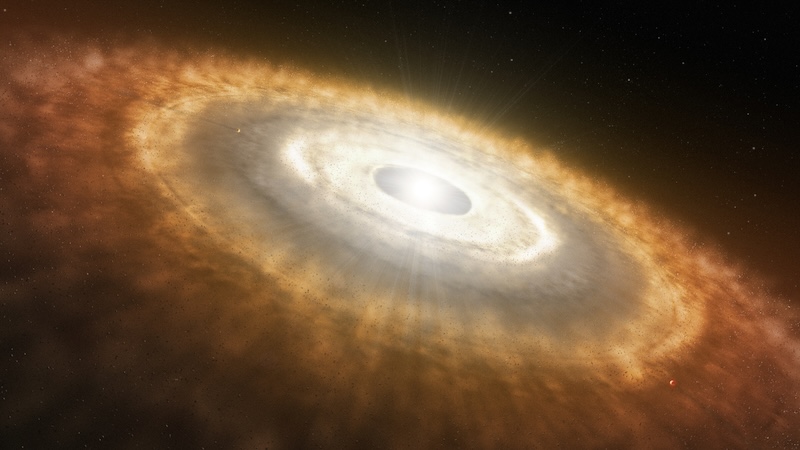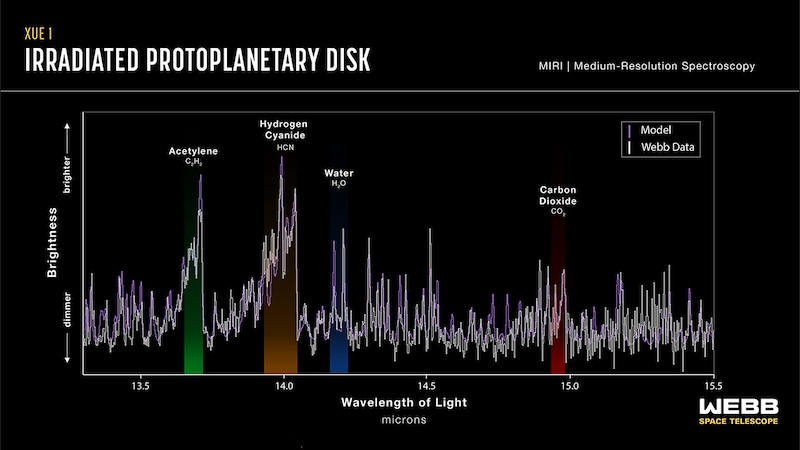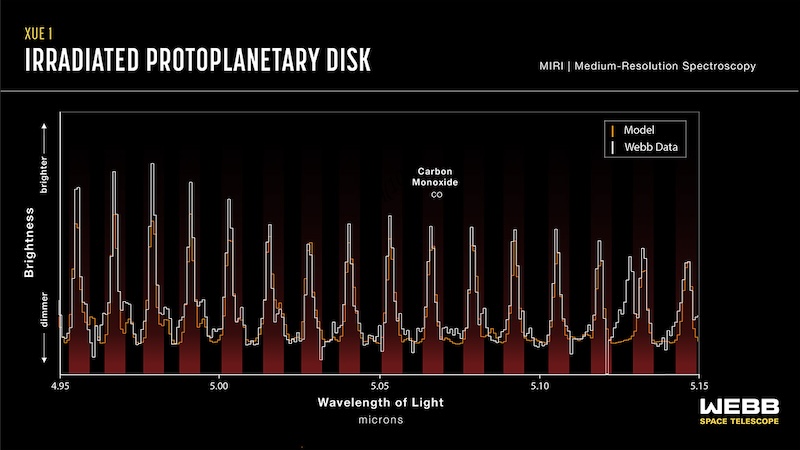
Astronomers have found an ever-growing number of rocky exoplanets, including some about the same size and mass as Earth, orbiting distant stars. Scientists have thought that these worlds form in relatively benign regions around their stars, that is, in places where ultraviolet radiation from their stars is relatively mild. Such radiation from stars can destroy the molecules that are the building blocks for rocky planets. But on November 30, 2023, an international team of researchers presented an alternative view. Using the James Webb Space Telescope, they found, for the first time, that rocky planets can form even in extreme radiation environments.
Webb detected a wide variety of planet-building molecules in a radiation-soaked region of a planet-forming disk, or protoplanetary disk, in the Lobster nebula (NGC 6537). It is just one of many disks in the nebula, 5,500 light-years away. These disks of dust and gas around young stars are where new planets are born.
The researchers published their peer-reviewed results in The Astrophysical Journal Letters on November 30, 2023.
The 2024 lunar calendars are here! Best Christmas gifts in the universe! Check ’em out here.
Building blocks of rocky exoplanets
Just like living organisms, planets are made from molecular building blocks. This can include water, carbon and many others. A lot of factors play in to what a planet will be like, including the environment it forms in around its star. If it is too close to the star, ultraviolet light can break apart many of those molecules.
Hence, scientists have thought that the best place for rocky planets to form is where there is less radiation. As in, a more benign region a bit farther out from their stars.
Webb makes surprising discovery
But now, Webb has made an unexpected discovery. It has found building blocks of rocky planets in an extreme and hostile environment in a protoplanetary disk about 5,500 light-years away in the Lobster nebula. Protoplanetary disks are massive flattened rotating disks of dust and gas around young stars. It is in these disks that planets – of all kinds – can form. The young stars in the Lobster nebula are massive, emitting much more ultraviolet radiation than smaller stars.
The Lobster nebula is a massive star-forming complex, and also one of the closest to us. Webb is the only telescope that currently can study planet-forming disks in such complexes. Lead author María Claudia Ramírez-Tannus, at the Max Planck Institute for Astronomy in Germany, stated:
Webb is the only telescope with the spatial resolution and sensitivity to study planet-forming disks in massive star-forming regions.
Webb targeted 15 protoplanetary disks in the Lobster nebula. In one of them, called XUE 1, Webb detected water, carbon monoxide, carbon dioxide, hydrogen cyanide, acetylene and partially crystalline silicate dust. All of those are building blocks for rocky planets.

One of the most extreme environments in our galaxy
What’s exciting is the molecules are in the inner region of the disk, which is highly irradiated by its star. These regions are some of the most extreme known in our galaxy. The fact that Webb has confirmed the existence of the molecules shows that rocky planets can, indeed, form in such hostile environments.
The researchers say that XUE 1 has likely been exposed to intense radiation ever since it first formed. And yet the rocky planet-forming molecules are still there. Co-author Rens Waters at Radboud University in the Netherlands said:
We find that the inner disk around XUE 1 is remarkably similar to those in nearby star-forming regions. We’ve detected water and other molecules like carbon monoxide, carbon dioxide, hydrogen cyanide and acetylene. However, the emission found was weaker than some models predicted. This might imply a small outer disk radius.
Co-author Lars Cuijpers, also at Radboud University, added:
We were surprised and excited because this is the first time that these molecules have been detected under these extreme conditions.

Good news for rocky exoplanets
So, why is this significant? Surprisingly, the results show that the conditions in the inner disk of XUE 1 are similar to those in protoplanetary disks around lower-mass stars. This means that the range of environments where rocky planets can form is much larger than previously thought. If rocky planets can form around both low-mass and high-mass stars, in both benign and extreme environments, then there are probably many more out there than astronomers had previously calculated.
The paper stated:
Our findings imply that the inner regions of highly irradiated disks can retain similar physical and chemical conditions to disks in low-mass star-forming regions, thus broadening the range of environments with similar conditions for inner disk rocky planet formation to the most extreme star-forming regions in our galaxy.
And if such worlds are abundant, then potentially more of them could be habitable.
How common are rocky exoplanets?
But just how common are rocky planets, overall? As Ramírez-Tannus noted:
XUE 1 shows us that the conditions to form rocky planets are there, so the next step is to check how common that is. We will observe other disks in the same region to determine the frequency with which these conditions can be observed.
Researchers will need to conduct additional observations, however, to determine the rate of rocky planet formation in extreme environments. As the paper said:
XUE 1 shows that the conditions for terrestrial planet formation can also happen in extreme environments. Nevertheless, the remaining observations from the XUE program are crucial to establish the frequency with which this occurs.
Also at the end of November, researchers from the U.K., Germany and the U.S. said they discovered the first known protoplanetary disk in another galaxy! This one is in the Large Magellanic Cloud, 160,000 light-years away.
Bottom line: NASA’s James Webb Space Telescope has found molecular building blocks of rocky exoplanets in a region previously thought to be too extreme and hostile.
Source: XUE: Molecular Inventory in the Inner Region of an Extremely Irradiated Protoplanetary Disk
Read more: Weird rocky exoplanets unlike any seen before
Read more: 1st planet-forming disk found in another galaxy
The post Rocky exoplanets can form in the most extreme environments first appeared on EarthSky.
0 Commentaires